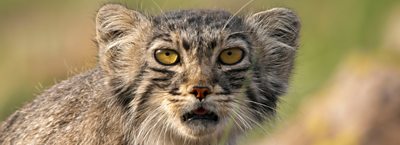In the heart of Asia lie vast arid lands which stretch from Arabia in the west to eastern China. These deserts and dry grasslands are so hostile they push life to the limit and demand extraordinary resilience. Animals that live here are among Asia’s greatest survivors.
The Gobi Desert in Mongolia is half a million square miles of emptiness. Yet it is home to one of the rarest animals on Earth - the Gobi bear. Fewer than forty are known to exist. Theirs is a solitary life, although they communicate by leaving their scent on ancient trees. Rare oases are lifelines for the bears, and a glimpse of a mother with a young cub represents a symbol of hope for this critically endangered species.
To escape the heat of the day most animals in the Gobi emerge at night. The long-eared jerboa is a curious creature that looks like a mixture of other species. It has a lion’s tail, a rabbit’s ears, the snout of a pig, and the legs of a kangaroo. It uses its acute senses to hunt in the dark. No desert insect is safe from this tiny hunter.
On the southern edge of Asia’s arid heart lies a desert that is full of life. The Thar, in India, is the most densely populated desert on earth home to twenty million people. Surprisingly, it is also filled with wildlife. Demoiselle cranes migrate thousands of miles to get here. In the village of Khichan the local Jain community welcome the cranes with open arms. Every day people put out one tonne of grain. This act of kindness has created one of the greatest bird spectacles on earth as thirty thousand cranes fill this little desert settlement with life.
On the edge of the Thar lies a parched scrub forest. This is the last refuge of a very special big cat: the Asiatic lion. They were once found from here to the Middle East. But now this small corner of India is the last place on earth where they exist. One lion mother must make a kill in order to feed her young cubs but, when they try to get involved in the hunt, they’re more of a hindrance than a help.
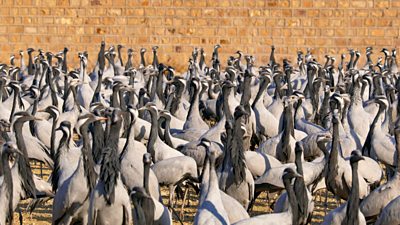
To the west of India lie some of the most inhospitable deserts on the planet. The Lut Desert, in Iran, is the hottest place on the Earth’s surface and the Rub Al Khali, or Empty Quarter – a vast sea of dunes in Arabia – is the largest expanse of sand in the world.
Sand from the Rub Al Khali is blown into the shallow seas of the Persian Gulf where it creates desert islands. One of these plays host to an extraordinary gathering of sixty thousand Socotra cormorants. They come here to raise a family, out of the reach of predators. But when chicks reach a certain age, they are abandoned. Whilst they wait for their adult feathers to grow, they’re marooned on the island and forced to resort to cannibalism to survive.
As the world warms, so Asia’s deserts are expanding. They are spreading into another great arid land - the Eurasian steppe, the largest grassland on earth. On the plains of Mongolia, a Pallas’s cat must contend with the lack of cover as she hunts for rodents. Eventually she gets close enough to make a strike – but not before she appears to mesmerise her prey by waggling her tail hypnotically in the air.
The arrival of winter transforms the steppe. Temperatures fall to minus 40C, and it’s now stripped of grass. Mongolian gazelles are the great nomads of these plains and their ancient migration takes them south in search of food. But nowadays a train line cuts the route in half, fenced in on both sides by barbed wire. The gazelles risk getting tangled as they push through the fence, others are taken by feral dogs which patrol the tracks. For those which escape, the migration continues, but for many others, it ends here.
Of all the large animals that live in this arid grassland, perhaps the most well adapted are the horses. Takhi are the last truly wild horses on Earth and they live in small family groups. At night wolves attempt to catch their foals. The Takhi stick together, and by working as a team, they are able to chase the wolves away.
- Watch all episodes of Asia on �鶹�� iPlayer and add to your Watchlist now
- Watch Asia, episode four on �鶹�� One from Sunday 8 December at 6.20pm
FS
Filming locations
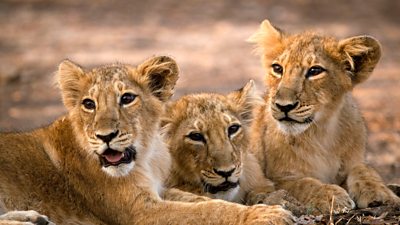
- Gobi bears: Great Gobi Strictly Protected Area ‘A’, Mongolia
- Long-eared jerboas: Gobi desert, Mongolia
- Demoiselle cranes: Khichan, India
- Asiatic lions: Gir National Park, India
- Lut desert: Lut desert, Iran
- Empty Quarter: Rub Al Kahli, UAE
- Socotra cormorants: Hawar Islands, Bahrain
- Pallas cat: Steppe grassland, Mongolia
- Mongolian gazelles: Steppe grassland, Mongolia
- Takhi and Mongolian wolves: Hustai National Park, Mongolia
Interesting facts
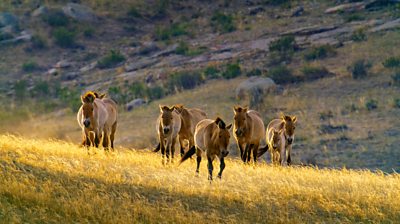
- The Gobi is one of the most extreme habitats on Earth – temperatures from minus 40 Celsius in winter to 45 Celsius in summer, with colossal sand dunes, minimal rainfall and extreme winds.
- There are fewer than 40 Gobi bears left in the wild, roaming an area of nearly 25,000 square kilometres. They are classified as ‘critically endangered’. Fewer than ten of them are female, putting strain on the population’s viability. The cubs filmed for the series were the first seen by scientists for seven years.
- The Lut Desert in Iran is the hottest place in the world – surface temperatures have hit 80 Celsius. It has been called the ‘Thermal Pole of Earth.’
- Mongolian gazelles can travel over 1,000 kilometres annually (the same as the entire length of Great Britain). Other than when they’re breeding, they’re forever on the move.
- Takhi are the only truly wild horse remaining, they have never been domesticated.
Filming feats
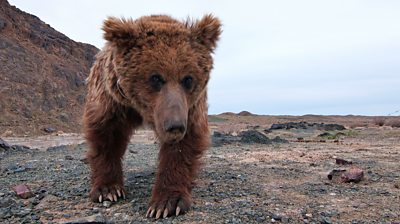
- This is the first time the Gobi bear has been filmed using broadcast-quality cameras.
- The team witnessed courtship rituals of the Socotra cormorant new to science, and also adults cannibalising young chicks, showing their desperation in this desolate landscape.
- It is the first time that wolf/takhi predation attempts have been filmed for a natural history series.
Technology and behind the scenes
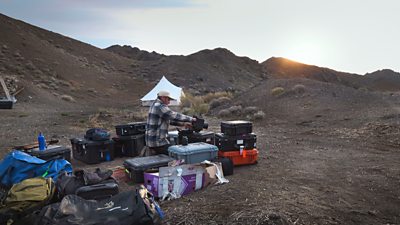
- The camera traps for the Gobi bear were in the field for a total of 450 days – almost 1.5 years. The team’s camera traps also filmed snow leopards, lynx, wolves and wild Bactrian camels.
- The team used state-of-the-art nest cameras to film Socotra cormorants, allowing full control just a metre from the nest. This allowed for unprecedented intimate shots of Socotra cormorants.
- It took two weeks for the team to find a Pallas’ cat den and then they spent three weeks watching and filming the same mother and five kittens. They had to put the crew in hides under cover of darkness to avoid disturbing the cats, but by the end of the shoot she was walking right past the team without a care in the world.
- It took the crew nine weeks to acquire the wolf/takhi night-time predation-attempt footage. The team would stake out a remote valley all night with military-grade night vision thermal cameras. During these long nights, the team were also treated to sightings of lynx and snow leopards.
